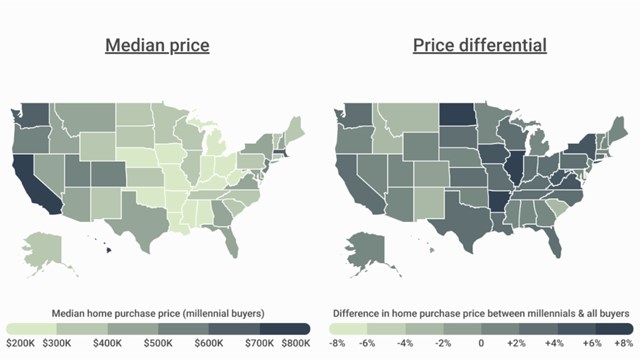Over the past few years, millennials (generally regarded as those born between 1981 and 1996) have become the largest and most important demographic group for marketing products and services – including homes. What separates millennials from older buyers – even those not much older than themselves – is their comfort with using technology and online resources to a much greater extent, and their prioritizing of more 'experiential' living.
Changing How Things Get Done
“The biggest challenge of working with younger buyers,” says Meri Galstian, a broker with MyBostonCondo.com, “is often that they will do their own research before they come to a realtor. They have so much technology and information at their disposal that working with a realtor is something many don’t realize has added value. They show up with more knowledge generally than older buyers, but once they come in to meet with us, that often changes. They’ve done their homework, [and] the upside of that is they have a handle on what’s out there – but at the same time, there is a lot of inaccurate and unreliable information on the Internet.”
Nicole Hay, an agent with New York brokerage firm Halstead, concurs. “Most of the time, millennials are very aware of what’s on the market,” she says, “because they are always on the web. Sometimes my clients will see something and send it to me and ask me what I think of it. It’s a different kind of client relationship. There’s a lot more back-and-forth conversation going on, usually though text.” Communications are now all day, not just from 9:00 a.m. to 6:00 p.m. She usually makes herself available 24/7. “I get texts at 11:30 p.m. from younger clients; the older generation doesn’t do that. The days of communicating by phone are behind us.”
Galstian describes a similar situation. “The communication is more casual, less formal,” she says. “ The pace changes. It’s 24/7 with millennials. Responding in real time – not by email – is important. That's easier for me, because I am a millennial. Many younger people relate to me because we are the same age. Older brokers find it difficult to adapt to millennial habits, like texting at midnight. Older buyers email, younger buyers text. Younger clients require more constant communication.”
Hay also uses social media – primarily Instagram – to market her listings. She lists apartments on the social media network, has conducted virtual tours, and has sold properties to her followers on the platform. She has also used FaceTime to show apartments (at least for a first look) when busy young clients can’t get to the unit in person but want to see it immediately. Hay says this has really worked for her. “Younger buyers are very dependent on their cellphones, and respond right away. This works well because it’s a great way to get an instantaneous response.”
What Are Younger Buyers Seeking?
Not only do younger buyers differ from their older counterparts in how they go about buying a home, they also have a different agenda when it comes to what they're looking for.
Perhaps the two most important overarching considerations for younger buyers are tech-ready spaces that are in move-in condition. Hay says her younger clients want spaces that include a sound system that can be hooked to their phones through systems like Sonos, security systems, and even in-apartment cameras—for baby rooms for instance—that can be viewed directly through their phone.
According to the pros consulted for this piece, millennial buyers show a real aversion to spaces that require lots of work, or that need to be gradually upgraded over time. They aren’t looking for ‘fixer-uppers' – they want turn-key properties ready for immediate occupancy. “A renovated apartment is always more important,” says Hay, “for millennials in particular. They are very interested in design.” Galstian points out that “amenities— tech in particular—will sell a smaller unit. Millennial buyers are fixated on technology, and will live in a smaller apartment to get the amenities they want.”
In terms of building amenities, Hay says that many younger buyers seek state-of-the-art fitness centers, or upscale gyms or spin studios close by. Pet-friendly policies are very important – so much so that many buildings in markets across the country are now offering pet play areas, or even pet spas. A no-dogs policy can quickly impact a building's ability to attract younger buyers. Another popular amenity are entertainment lounges that residents can reserve or rent to hold gatherings that wouldn't fit in their unit. Rooftop spaces are a big draw as well for the same reason. According to the pros, this generation wants private and common spaces that integrate into their lifestyle.
The considerations are similar when choosing a neighborhood. Restaurants, gym facilities, coffee houses and entertainment venues are all high on the list of things young buyers look for as they weigh their options. For younger buyers who work all or part-time from home, neighborhoods with laptop-friendly places such as all-day coffeehouses or shared-work spaces may also be a strong draw.
Getting the Tech Right
Ralph Scrofani is a partner at the New York/New Jersey-based Intra Home Systems LLC, a company that provides in-home technology for everything ranging from security systems to remote-controlled window shades. “In terms of tech,” he says, “[young buyers] are looking for great infrastructure. They want wiring on their homes that provides entertainment, high-speed Internet throughout the space, music, motorized window treatments, high-def television, etc.” Interestingly, Scrofani points out that when it comes to intercom systems, millennials are not generally interested in wall-mounted LED screen systems, preferring security that's accessible from their phones. According to Scrofani: “They also like a system that can be easily integrated with AI systems like Alexa, Google Home, or Josh AI.”
Scrofani is often consulted by developers before construction, and his company and their services become part of the development plan and team. He also provides services to apartment owners on a direct, client-by-client basis. Clearly, explains Scrofani, it is easier to provide these types of tech options when a building is under construction or total renovation, but they can be installed in any existing unit. “Individual unit retrofits are a little bit more difficult,” he says. “There’s a lot of cutting, patching, and painting.”
While he sells tech services to people of all ages, he points out that there is a difference in how different age brackets do things. Older clients take a more traditional approach, requesting a proposal from him. Younger clients tend to have done more research before calling him in. They know what they want when they contact him to arrange for installation. “The simple fact of the matter is,” he says, “that younger clients do more pre-research and are more tech-savvy.” For millennials, he notes, the top tech choices are wireless networks with wireless access points, and high-speed Internet service, which is necessary for everything from gaming to using Peloton bikes.
Condo Versus Co-op
Another consideration for millennial buyers is whether they prefer a condo or a co-op. This choice generally relates to a buyer's ability to meet the financial requirements for one or the other. Hay relates that millennials generally prefer condos, but that the decision may often rest on how much cash they have to get into the apartment. A big drawback with co-ops is the cash-on-hand that many co-op boards require from a buyer – as well as the board interview. These requirements can often mean cash deposits equaling up to a year of maintenance and mortgage payments, in addition to the down payment and closing costs required to acquire the apartment. If the young purchaser’s parents are helping out, explains Hay, that may often affect their decision on whether to purchase a co-op or condo.
In the final analysis, millennial buyers are transforming the real estate market in the same way they are transforming every other part of the consumer economy. Their realities are different than previous generations. As Galstian says: “Millennials get a bad rap, that they are always looking for short-term gratification. But we have less certainty in our view of the future than older generations as a result of the Great Recession and how it affected our outlook. We like flexibility.” Their way is the future. The real estate industry will undoubtedly adjust.
A J Sidransky is a staff writer/reporter for The Cooperator.







Leave a Comment